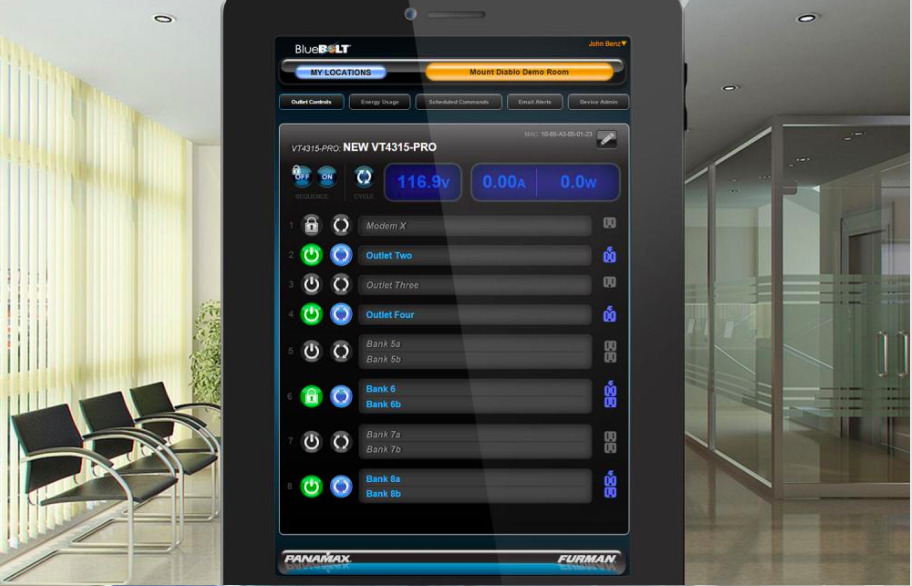Service calls are a basic operational reality for any integration company. There will always be the possibility of minor issues with equipment, power fluctuations, user errors, and other incidents that require professional assistance to solve. But what if commercial integrators could fix 80 to 90 percent of customers’ problems on their smartphone or computer—without having to be on site—while also adding a new recurring revenue stream to their business income?
Using the latest remote energy management solutions, this dream is becoming a reality for integrators all over the country. Solutions such as BlueBOLT, a remote energy management product and service from Panamax and Furman, are giving integrators and their clients fast, simple, and cost-effective ways to manage many of the most common system issues. Here we’ll review the basics of remote energy management and the many benefits it provides integrators and their clients.
What are remote energy management systems?
In general, modern remote energy management systems provide an internet or app-based portal where integrators can track power usage and status for entire systems and individual components, cycle power on and off to solve issues with routers or other equipment, verify network connections are active, schedule power conservation, and deliver instant email alerts for issues such as a power outage or an unresponsive component.
[Getting in Front of the Power and Cable Management That’s Behind Every Installation]
The latest models and services offer more advanced automation such as network processes that can ping the router, the modem, and a website in specific orders to test exactly what the issue is, then attempt fixes without human intervention.
How can remote energy management boost a company’s bottom line?
One of the most important factors for the success of an integration business is a happy clientele that engages in repeat business and refers other potential clients. Demonstrating the ability to fix problems within minutes is an excellent way for professionals to prove their value, and that’s exactly what remote energy management offers. For a small monthly fee—usually less than $10 per month—integrators can offer clients nearly-instant fixes to common issues, plus advanced control over their power consumption. Depending on how many clients an integrator has, this could be a significant source of recurring revenue.
The financial benefits for integrators extend well beyond an additional revenue stream. Any service call that can be solved without rolling a truck saves significant resources and worker hours that can be devoted to other tasks. Deeper-rooted issues such as inconsistent building voltage can be quickly diagnosed through power-tracking features, increasing the perceived value of the integrator’s services and expertise.
Perhaps most importantly, remote management allows 24/7 online access from anywhere in the world, so integrators never have to leave a client waiting for a router reboot. Warranty service calls that previously required a truck and worker for non-billable time can be completed remotely in minutes, introducing huge cost savings and therefore increasing profit over the life of a client relationship.
How should remote energy management be presented to clients?
How should remote energy management be presented to clients?
Having an effective sales pitch for a monthly service agreement is crucial. Most clients place reliability and usability at the top of their list of needs. They want their expensive technologies to work every day, and they want to know that if problems do occur, they can be handled efficiently without additional expense.
A good place to start is by explaining that the most common problems, such as router or network issues, can be automatically monitored and fixed within minutes—not hours, not days, but minutes. A second huge benefit is the integrator’s ability to notice problems even before the client does. If a homeowner’s network goes on the fritz while they are at work, the integrator can have it fixed before the client even realizes it! It’s an almost unimaginably high level of service, and it helps clients feel that their integration team is going above and beyond for them.
For energy-conscious clients, highlighting the scheduling capability could be a big selling point. Particularly for commercial customers that may be closed for half the day, regulating energy usage in off-hours could more than offset the monthly service fee, while providing them with a positive image as an eco-conscious company.
Are there other business benefits besides revenue?
Another significant advantage for integrators is the ability to access potentially thousands of clients’ systems from a single interface, and even set up special names for high-priority clients so workers can quickly check statuses. For smaller integration firms, the ability to log in from anywhere—the office, another job site, at home, on vacation—could enable a much higher level of responsiveness, which doesn’t directly earn more money, but it does elevate the company’s reputation and future prospects. Depending on the system used, remote energy management services can also simplify other aspects of system maintenance, such as auto-discovery and configuration of newly connected devices.
Having an on-demand monitoring service also increases the opportunity for regular contact with a client long after a project is completed. Any time an integrator fixes an issue remotely, they gain an opportunity to email or call the client and let them know what happened. In that conversation, they can ask if the client has any other needs or any new work they may be looking to contract.
What’s the best way to begin offering remote energy management?
Several power product manufacturers offer excellent IP-based monitoring solutions, so integrators are encouraged to research the latest products and consider the capability, compatibility, and upgradeability of hardware, while also sampling the different software solutions to determine which is best for their company and employees. The system that’s easiest to use is often the most useful.
It could be helpful to label the service as a “personal service agreement” or a “same-day service agreement”—how it’s marketed or listed on marketing materials can greatly affect clients’ interest. The more clients that know a few dollars a month can buy them 24/7 problem-solvers to detect and fix issues before they’re even noticed, the more clients will want and even demand the service.

